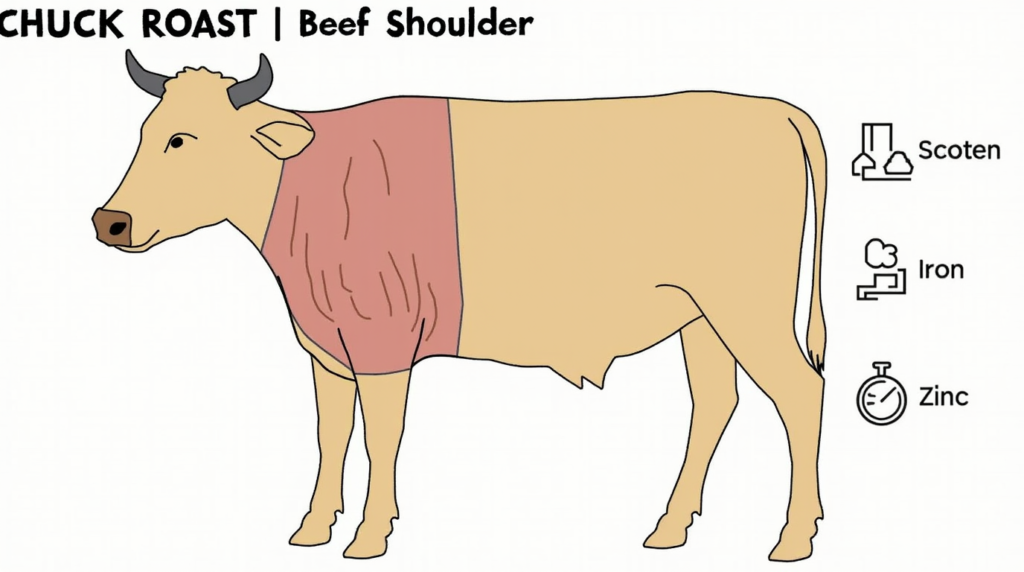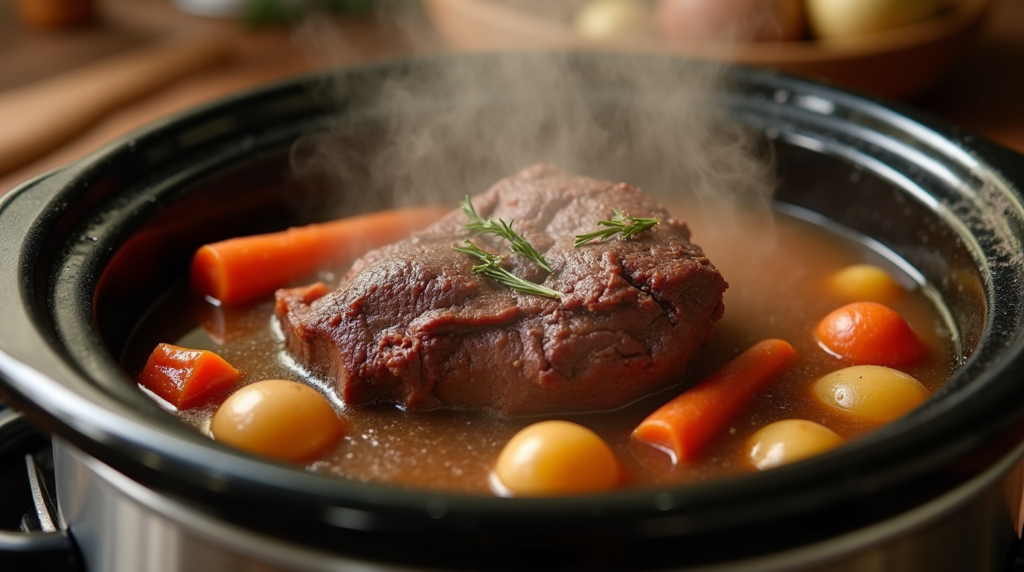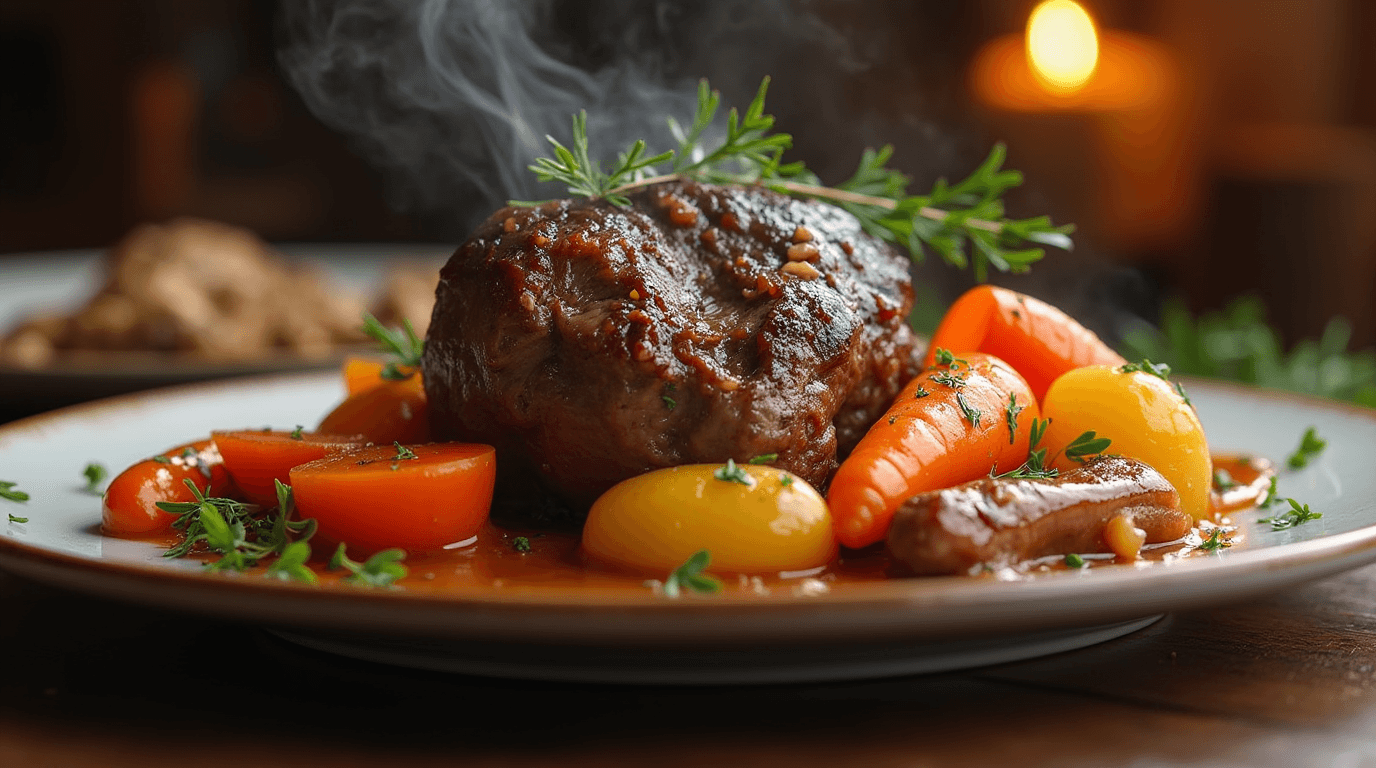Beef Shoulder Roast Recipe: Tender, Flavorful One-Pot Dinner
Are you looking for a hearty, comforting meal that’s easy to prepare? Look no further than a tender and flavorful one-pot dinner made with a delicious cut of meat. This dish is perfect for a weeknight dinner or a special occasion, offering a rich, satisfying flavor profile that’s sure to please.
Cooking a beef shoulder roast recipe can seem intimidating, but with the right simple recipe, you can achieve a tender, fall-apart texture and a deep, meaty flavor. The beauty of this roast beef and recipe lies in its simplicity and the minimal cleanup required, as everything cooks together in one pot.
Key Takeaways
- Easy to prepare with minimal ingredients
- Tender and flavorful results with a fall-apart texture
- Perfect for weeknight dinners or special occasions
- Cooks in one pot, reducing cleanup
- Rich, satisfying flavor profile
- Versatile recipe that can be adjusted to suit different tastes
Understanding Beef Shoulder Roast
When it comes to a hearty, comforting meal, few options compare to a well-cooked beef shoulder roast. This cut of beef is not only flavorful but also packed with nutrients, making it a great choice for a family dinner.
What Is a Beef Shoulder Roast?
A beef shoulder roast, often referred to as a chuck roast, comes from the shoulder area of the cow. It’s a tougher cut that’s perfect for slow cooking, as this method breaks down the connective tissues, resulting in tender, fall-apart meat.

Nutritional Benefits of Beef Shoulder
Beef shoulder is rich in proteins, vitamins, and minerals. It’s an excellent source of iron and zinc, essential for healthy red blood cells and a robust immune system. A 3-ounce serving of cooked beef shoulder roast contains about 220 calories, 35% of the daily recommended intake of protein, and various essential nutrients.
| Nutrient | Amount per 3 oz Serving | % Daily Value |
|---|---|---|
| Protein | 22 grams | 44% |
| Iron | 3 mg | 15% |
| Zinc | 4 mg | 25% |
Different Names and Cuts of Shoulder Roast
Beef shoulder roast is known by several names depending on the region and the specific cut. Common names include chuck roast, shoulder clod, and blade roast. Understanding these different names can help you navigate the butcher’s counter or grocery store more effectively.
“The beef shoulder is a versatile cut that can be cooked in various ways, from slow roasting to braising, making it a favorite among chefs and home cooks alike.”
Why Choose Beef Shoulder for Your Roast
When it comes to roasting, beef shoulder stands out as a superior choice due to its rich flavor and tender texture. This cut is not only delicious but also offers several practical advantages that make it ideal for a variety of cooking situations.
Flavor Profile Compared to Other Cuts
Beef shoulder boasts a robust, beefy flavor that surpasses many other cuts. The marbling throughout the meat ensures that it stays juicy and develops a rich, savory taste when cooked. As Julia Child once said, “The only time to eat diet food is while you’re waiting for the steak to cook.” In comparison to leaner cuts, the shoulder’s higher fat content makes it more tender and flavorful, especially when cooked low and slow.
Cost-Effectiveness of Shoulder Cuts
One of the most significant advantages of beef shoulder is its cost-effectiveness. It is generally one of the more affordable cuts, making it an excellent choice for large gatherings or family meals. You can achieve a high-quality roast without breaking the bank, which is a significant plus when cooking a roast in the oven for a crowd.
Ideal Cooking Methods for Shoulder Roast
The beef shoulder roast is incredibly versatile and can be cooked using various methods, including braising, slow cooking, and roasting. For an oven roast, it’s best to use a low and slow approach to break down the connective tissues, resulting in tender, fall-apart meat. This makes it perfect for a comforting, hands-off meal.
Essential Equipment for the Perfect Beef Shoulder Roast
Cooking a beef shoulder roast to perfection requires more than just a good recipe; it demands the right tools. The choice of cooking vessel and equipment can significantly impact the final result, making it tender, flavorful, and enjoyable.
Dutch Ovens vs. Roasting Pans
When it comes to cooking a beef shoulder roast, two popular options are Dutch ovens and roasting pans. A Dutch oven provides even heat distribution and retains moisture, ideal for slow cooking. On the other hand, a roasting pan allows for better browning and crisping of the roast’s surface.
| Feature | Dutch Oven | Roasting Pan |
|---|---|---|
| Heat Distribution | Even | Variable |
| Moisture Retention | High | Low |
| Browning Capability | Good | Excellent |
Meat Thermometers and Other Helpful Tools
A meat thermometer is a crucial tool for ensuring your roast is cooked to the desired level of doneness. Other helpful tools include a sharp knife for trimming, kitchen twine for tying the roast, and a roasting rack for elevating the meat.
Slow Cooker and Pressure Cooker Options
For those who prefer hands-off cooking, a slow cooker or pressure cooker can be an excellent choice. Using a slow cooker, such as cooking a beef shoulder roast crock pot style, allows for long, slow cooking, while a pressure cooker can significantly reduce cooking time.
Selecting the Best Beef Shoulder Roast at the Store
Selecting the perfect beef shoulder roast involves understanding a few key elements that can elevate your dining experience. When you’re at the store, you’re faced with numerous options, making the decision a bit daunting.
Grades of Beef and What They Mean
Beef is graded based on its quality and yield. The most common grades you’ll encounter are Prime, Choice, and Select. Prime beef offers the highest quality with abundant marbling, making it tender and flavorful. Choice is also of high quality but has less marbling than Prime. Select is leaner and may be less tender.
| Beef Grade | Description | Marbling Level |
|---|---|---|
| Prime | Highest quality, tender, and flavorful | Abundant |
| Choice | High quality, less marbling than Prime | Moderate |
| Select | Leaner, may be less tender | Low |
Size Considerations for Your Gathering
The size of the roast you need depends on the number of people you’re planning to serve. A general rule of thumb is to plan for about 1 pound of beef per person. So, for a gathering of 8, you would need an 8-pound roast.
Fresh vs. Frozen Shoulder Roasts
You’ll also need to decide between fresh and frozen shoulder roasts. Fresh roasts are often preferred for their texture and flavor, but frozen roasts can be just as good if thawed properly. Frozen options might offer more flexibility in terms of storage and can be just as nutritious.
Preparing Your Beef Shoulder Roast Before Cooking
Before you start cooking your beef shoulder roast, a few simple preparation steps can significantly enhance its flavor and texture. Proper preparation is key to achieving a tender and delicious roast.
Trimming and Tying Techniques
Trimming excess fat from your beef shoulder roast can help it cook more evenly. Use a sharp knife to remove any large chunks of fat. Tying the roast with kitchen twine helps it maintain a uniform shape, ensuring consistent cooking.
Dry Brining: A Game-Changing Step
Dry brining involves rubbing the roast with salt and letting it sit in the refrigerator. This process enhances the roast’s natural flavors and texture.
| Preparation Step | Benefit |
|---|---|
| Trimming | Even cooking, less fat |
| Dry Brining | Enhanced flavor, tender texture |
Perfect Seasoning Combinations
Using the right seasoning can elevate your beef shoulder roast. Consider combining garlic powder, paprika, and thyme for a classic flavor profile.
Marinating Options for Extra Flavor
Marinating your roast can add an extra layer of flavor. Use a mixture of olive oil, soy sauce, and herbs for a delicious and savory roast.
The Ultimate Beef Shoulder Roast Recipe
Discover the secret to a tender and flavorful beef shoulder roast with our step-by-step guide. This recipe is designed to help you achieve a deliciously cooked roast beef that’s sure to impress your family and friends.
Ingredients List
To make this mouth-watering beef shoulder roast, you’ll need the following ingredients:
- 3-4 pound beef shoulder roast
- 2 tablespoons olive oil
- 1 onion, chopped
- 3 cloves garlic, minced
- 1 cup beef broth
- 1 cup red wine (optional)
- 2 carrots, peeled and chopped
- 2 potatoes, peeled and chopped
- 1 teaspoon dried thyme
- 1 teaspoon dried rosemary
- Salt and pepper, to taste
Step-by-Step Cooking Instructions
Follow these easy steps to cook your beef shoulder roast to perfection:
- Preheat your oven to 300°F (150°C).
- Season the beef shoulder roast with salt, pepper, thyme, and rosemary.
- Heat the olive oil in a large Dutch oven over medium-high heat. Sear the roast until browned on all sides, about 2-3 minutes per side.
- Add the chopped onion and minced garlic to the pot, cooking until the onion is translucent.
- Add the beef broth, red wine (if using), carrots, and potatoes to the pot. Cover the Dutch oven.
- Transfer the pot to the preheated oven and roast for 2 1/2 to 3 hours, or until the meat is tender.
Cooking Times and Temperature Guide
The key to a tender beef shoulder roast is cooking it low and slow. Here are some general guidelines for cooking times and temperatures:
- 300°F (150°C): 2 1/2 to 3 hours
- 325°F (165°C): 2 to 2 1/2 hours
Use a meat thermometer to ensure the internal temperature reaches 160°F (71°C) for medium-rare, 170°F (77°C) for medium, and 180°F (82°C) for well-done.
How to Tell When Your Roast Is Done
Besides using a meat thermometer, you can check if your roast is done by:
- Inserting a fork or knife into the meat; if it slides in easily, the roast is tender.
- Checking the meat’s texture; a done roast will be easily shredded with a fork.
By following these steps and guidelines, you’ll be able to achieve a perfectly cooked beef shoulder roast that’s sure to become a favorite in your household.
Mastering Cooking a Roast in the Oven
Oven roasting is a simple yet nuanced cooking method that, when mastered, yields delicious results. To achieve a perfectly cooked roast, it’s essential to understand the various techniques involved.
Low and Slow Method for Tender Results
The low and slow method involves cooking the roast at a lower temperature for an extended period. This technique breaks down the connective tissues in the meat, resulting in a tender and flavorful roast. To implement this method, preheat your oven to 275°F (135°C) and cook the roast for about 3-4 hours, or until it reaches your desired level of doneness.
High-Heat Searing Techniques
High-heat searing involves quickly cooking the surface of the roast at a high temperature to create a crust. This technique enhances the flavor and texture of the roast. To sear your roast, preheat your oven to 450°F (230°C), season the roast, and then cook it for 20-30 minutes, or until a nice crust forms. After searing, you can finish cooking the roast at a lower temperature.
Managing Oven Temperature Fluctuations
Oven temperature fluctuations can affect the cooking process. To manage this, use an oven thermometer to ensure the temperature is accurate. If your oven tends to run hot or cold, adjust the cooking time accordingly. It’s also helpful to minimize opening the oven door during cooking to maintain a consistent temperature.
Resting Your Oven Roast Properly
Resting your roast after cooking is crucial. It allows the juices to redistribute, making the roast more tender and flavorful. To rest your roast, remove it from the oven and let it sit for 15-30 minutes before slicing. Tenting the roast with foil during resting can help retain heat.
| Cooking Method | Temperature | Cooking Time |
|---|---|---|
| Low and Slow | 275°F (135°C) | 3-4 hours |
| High-Heat Searing | 450°F (230°C) | 20-30 minutes |
Beef Shoulder Roast Crock Pot Method
Slow cooking a beef shoulder roast in a crock pot yields incredibly tender results. This method is perfect for those who want to come home to a ready-to-eat meal. The crock pot’s slow cooking process breaks down the connective tissues in the meat, making it fall-apart tender.

Adapting the Recipe for Slow Cooking
To adapt your beef shoulder roast recipe for the crock pot, you’ll need to adjust the cooking time and liquid levels. Start by seasoning the roast as you normally would, then place it in the crock pot. You can add your choice of vegetables and broth to the pot, ensuring the roast is mostly submerged.
Timing Differences for Crock Pot Cooking
Cooking time in a crock pot varies based on the size of your roast and your desired level of tenderness. Generally, a 2-3 pound roast will take 8-10 hours on low or 4-6 hours on high. Use a meat thermometer to check for doneness, aiming for an internal temperature of at least 160°F.
Adding Vegetables to Your Slow Cooker Roast
Adding vegetables like carrots, potatoes, and onions to the crock pot with your roast can create a complete meal. These vegetables not only absorb the flavorful juices but also become tender and delicious. Add them towards the end of the cooking time to prevent overcooking.
Slow Cooker Troubleshooting Tips
If your roast isn’t tender, it may need more cooking time. Ensure your crock pot is functioning correctly and that you’re using enough liquid. If the roast is browning too much, you can add a bit more liquid or cover the top with foil.
Creating a Flavorful Gravy from Your Roast Drippings
A delicious gravy is the crowning glory of a roast dinner, and making one from your roast drippings is easier than you think. The key to a great gravy lies in utilizing the rich, caramelized drippings left in the pan after roasting your beef shoulder.
Basic Pan Gravy Technique
To start, you’ll need to deglaze the pan by adding a small amount of liquid to the hot roasting pan, scraping up the browned bits from the bottom. This liquid can be stock, wine, or even water. Once you’ve loosened the flavorful residue, you can use this mixture as the base of your gravy.
Next, you’ll need to thicken the gravy. There are several methods to achieve the desired consistency, which we’ll explore in more detail later.
Enhancing Your Gravy with Herbs and Wine
To add an extra layer of flavor to your gravy, consider incorporating herbs or a splash of wine. Herbs like thyme, rosemary, or parsley can complement the beef’s flavor profile, while a red or white wine can add depth and complexity.
Thickening Methods: Flour vs. Cornstarch
When it comes to thickening your gravy, you have two primary options: flour and cornstarch. Flour is a traditional choice, often used to make a roux with fat or oil before gradually adding the pan drippings. Cornstarch, on the other hand, is a gluten-free alternative that can be mixed with a small amount of cold water before being added to the gravy.
| Thickening Agent | Method | Pros & Cons |
|---|---|---|
| Flour | Make a roux with fat, then add drippings | Pros: Traditional flavor, easy to make. Cons: Can be lumpy if not whisked properly. |
| Cornstarch | Mix with cold water, then add to gravy | Pros: Gluten-free, quick to thicken. Cons: Can make the gravy cloudy if not mixed correctly. |
Perfect Side Dishes to Complement Your Beef Chuck Recipes from the Oven
Complementing your oven-roasted beef chuck with the right sides can make your meal unforgettable. The key is to balance flavors and textures.
Traditional Vegetable Pairings
Classic options like roasted carrots, green beans, and Brussels sprouts are timeless choices. They complement the rich flavor of beef chuck.
Starch Options That Soak Up the Delicious Juices
Mashed potatoes, egg noodles, and crusty bread are excellent for soaking up the savory juices of your roast.
| Side Dish | Preparation Time |
|---|---|
| Mashed Potatoes | 30 minutes |
| Roasted Carrots | 25 minutes |
| Egg Noodles | 15 minutes |
Make-Ahead Sides for Easier Entertaining
Consider making sides like mashed potatoes or roasted vegetables ahead of time to simplify your hosting experience.
Creative Ways to Use Leftover Roast Beef
Leftover roast beef is a treasure trove of possibilities, from hearty sandwiches to comforting soups. With a bit of creativity, you can transform last night’s dinner into tomorrow’s exciting lunch or breakfast.
Sandwiches and Wraps
One of the simplest ways to enjoy leftover roast beef is in sandwiches and wraps. Thinly slice the beef and layer it between your favorite bread, adding horseradish sauce or au jus for extra flavor. Consider adding some crispy onions or melted cheese to elevate your sandwich.
Soups and Stews
Using leftover roast beef, you can create a delicious and comforting soup or stew. Simply chop the beef into bite-sized pieces and add it to your favorite broth along with vegetables like carrots, potatoes, and onions.
Hash and Breakfast Dishes
Dice the leftover roast beef and mix it with diced potatoes, onions, and bell peppers to make a hearty hash. Serve it with eggs for a filling breakfast. You can also use the roast beef in breakfast burritos or omelets.
Freezing and Storing Leftover Roast Beef
If you can’t use up all your leftover roast beef immediately, consider freezing it for later. Slice or chop the beef, then store it in airtight containers or freezer bags. When you’re ready, simply thaw and reheat it for a quick meal.
Conclusion: Enjoying Your Perfect Beef Shoulder Roast
Now that you’ve mastered the art of cooking a tender and flavorful beef shoulder roast, it’s time to savor the fruits of your labor. A perfectly cooked roast is more than just a meal; it’s an experience that brings people together. Whether you’re serving it at a special occasion or a cozy family dinner, your beef shoulder roast recipe is sure to impress.
As you’ve learned, the key to a delicious roast lies in the preparation and cooking technique. From selecting the right cut to achieving the perfect doneness, every step contributes to the overall flavor and tenderness. Don’t be afraid to experiment with different seasonings and accompaniments to make the dish your own.
Enjoying roast beef is not just about the taste; it’s about creating memories around the dinner table. So, take a moment to appreciate the joy of sharing a meal with loved ones. Your perfectly cooked beef shoulder roast is a testament to your culinary skills, and with this recipe, you’re sure to become the go-to chef for family gatherings and special occasions.
FAQ
What is the best temperature for cooking a roast beef in the oven?
The ideal temperature for cooking a roast beef in the oven is between 300°F to 325°F for a low and slow cooking method, which helps to achieve tender results.
How long does it take to cook a beef shoulder roast in a crock pot?
Cooking a beef shoulder roast in a crock pot typically takes 8-10 hours on low heat or 4-6 hours on high heat, depending on the size and thickness of the roast.
Can I use a beef chuck roast recipe for oven roast?
Yes, you can use a beef chuck roast recipe for oven roast. Beef chuck roast is a suitable cut for oven roasting, and it can be cooked using a similar method to beef shoulder roast.
What are some common seasonings used for roast beef?
Common seasonings used for roast beef include salt, pepper, garlic powder, onion powder, thyme, and rosemary. You can also use a dry brine or marinade to add extra flavor.
How do I know when my roast beef is done?
You can check if your roast beef is done by using a meat thermometer to check the internal temperature. The recommended internal temperature for medium-rare is 130°F to 135°F, medium is 140°F to 145°F, and well-done is 160°F to 170°F.
Can I cook a frozen beef shoulder roast in the oven?
It’s not recommended to cook a frozen beef shoulder roast in the oven. Instead, thaw the roast first, either by leaving it in the refrigerator overnight or by thawing it in cold water. This ensures even cooking and food safety.
What’s the difference between a beef shoulder roast and a beef chuck roast?
Beef shoulder roast and beef chuck roast come from different parts of the cow. Beef shoulder roast is typically more tender and leaner, while beef chuck roast is often fattier and more flavorful. Both can be used for roasting, but the cooking methods and results may vary.
Leave a Review & Rate This Recipe!
There are no reviews yet. Be the first one to write one.

